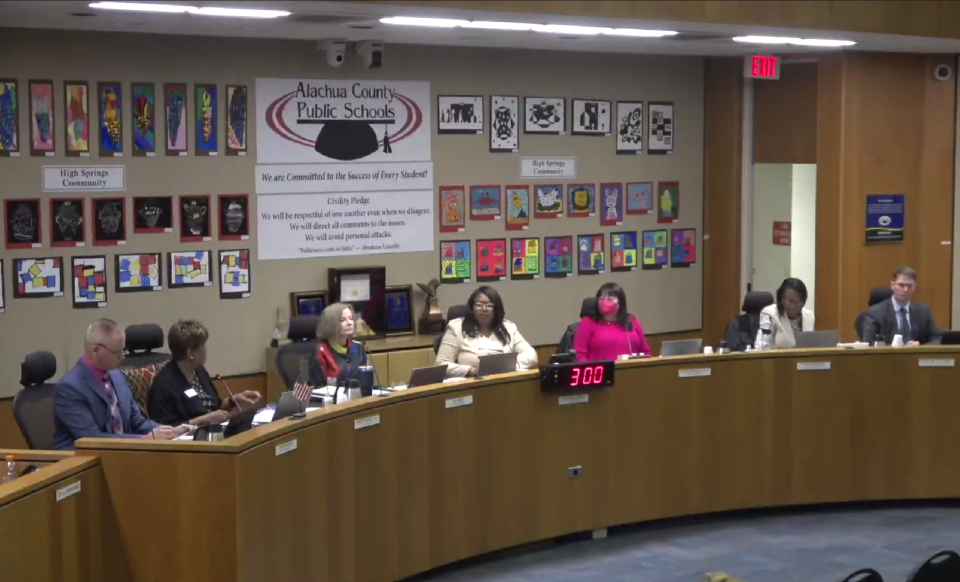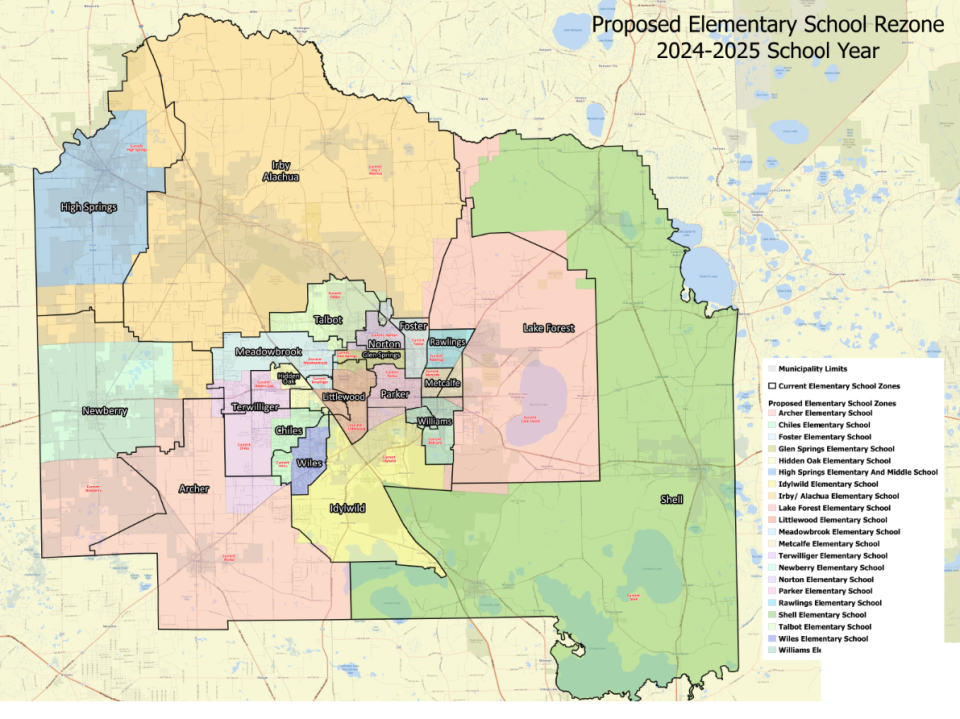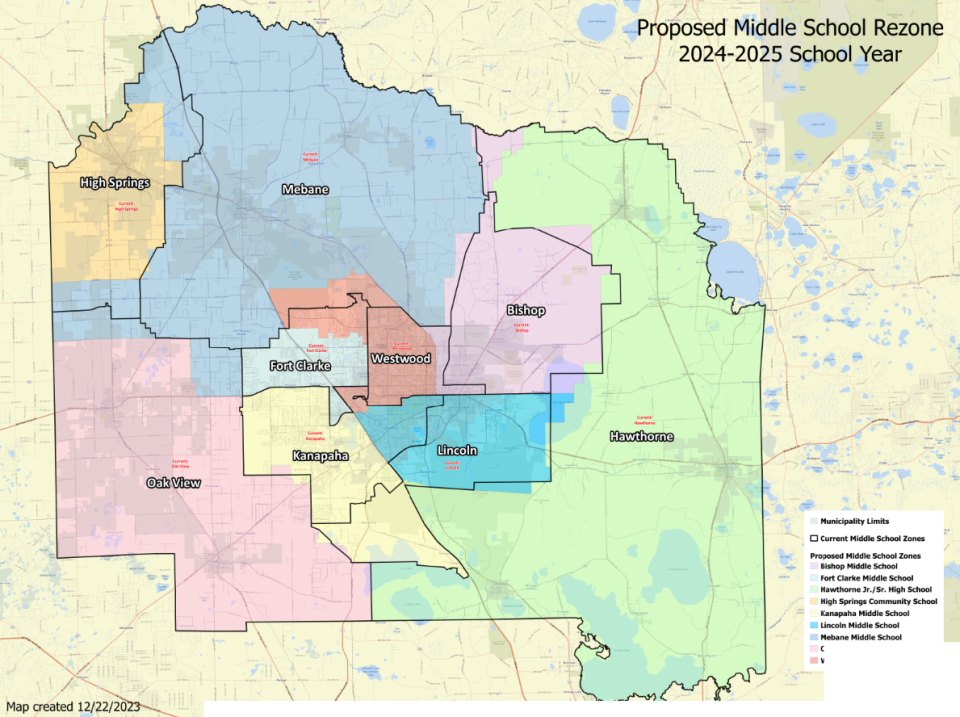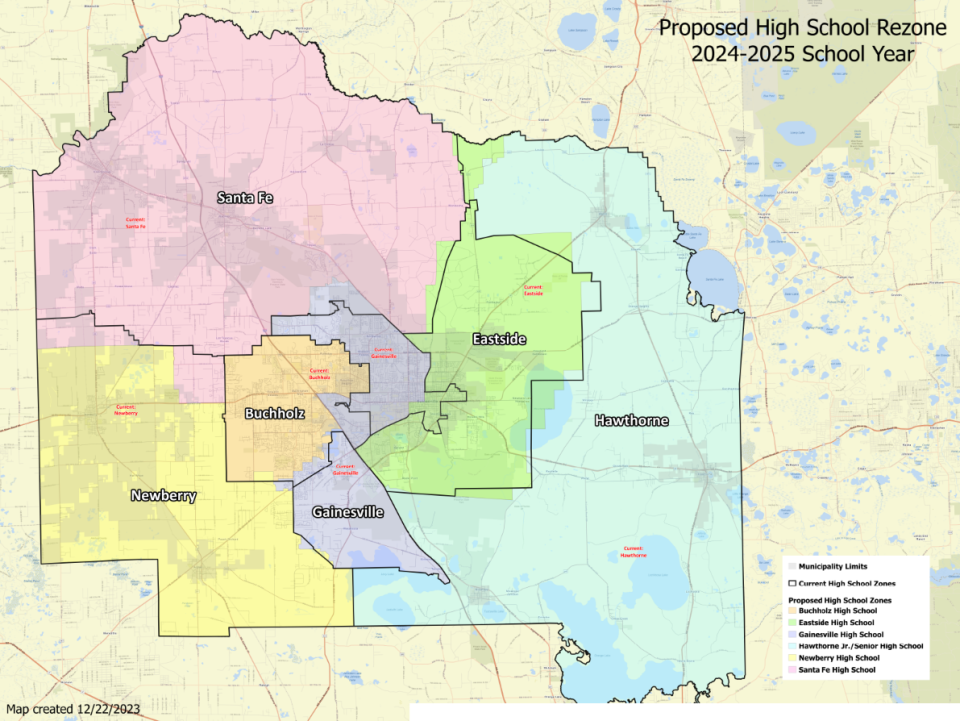No change: What happened to the school district's comprehensive rezoning plan?
The Alachua County School Board held a special meeting Thursday with only one thing on the agenda: the district’s comprehensive rezoning plan.
School board members passed the first reading of the rezoning plan in October, setting a 90-day window to officially adopt the plan for the 2024-2025 school year. A second vote was initially scheduled for November 2023, but then pushed to December and now, finally, was held Thursday.
Board members voted on their priorities in November 2022 and agreed to make rezoning a main priority. They then directed Superintendent Shane Andrew and his staff, in February, to begin a spot rezoning process that would choose some schools around the district and move students around to alleviate overcrowding.
At the start: 4 elementary schools in Alachua County to be rezoned by next school year
However, within two months of being tasked with spot rezoning, Andrew said spot rezoning was unable to be accomplished for the next school year and recommended comprehensive rezoning – a feat that hasn’t been done in the district for 40 years and would affect thousands of families in the county.
After nearly a year of attempting to complete a comprehensive rezoning process for schools in Alachua County, the district’s current maps still show 15 schools over capacity – which it defines as 90% or more enrollment.
There have been concerns since the district began the comprehensive rezoning process, such as the district not providing capacity data, not factoring diversity as a priority and being unable to show how the plan saves money or improves transportation issues.
During Thursday’s meeting Andrew recommended that the zones should remain as currently structured, allowing the district to continue with the process and implement new zones in the 2025-2026 school year instead. Reasons he gave for extending the process included disruption to students, adjusted bus routes beginning this month and allowing more time for the data collection and analysis process to unfold, among others.
“Rezoning work will not cease and will continue to be an ongoing priority for the school district,” Andrew said. “Our Alachua County Public Schools staff needs time to continue with all of the aforementioned work on behalf of our students without the uncertainty of rezoning for the 2024-2025 school year.”
The board votes

The school board voted 4-1 Thursday evening to not change current zone lines until further options and data can be brought to the school board. This means that, despite an almost year-long effort as well as money given to a private firm to assist with the rezoning process, the new comprehensive rezoning plan will now be implemented in the 2025-2026 school year.
Board member Tina Certain was the only opposing vote and suggested that the superintendent and staff were to blame for the failure to produce a substantial comprehensive rezoning plan.
“That’s a failure. That’s a leadership failure,” Certain said. “I don’t want the citizens to be blaming the board for this decision, because this is something – this plan and this work – this is a body of work that was done outside of the five board members. We gave the directive, and this is what was brought back to us.”
The process: School Board moves forward with rezoning despite uncertainty of district's capability
Questions and concerns: Proposed rezoning maps leave school board members with more questions than answers
Certain mentioned the low socioeconomic status (SES) of schools, particularly in east Gainesville, as a concern that was not addressed or improved through the proposed rezoning maps. By leaving the zone lines the way they are, she said, there is a significant impact on the district to having overcrowded and under enrolled schools in the district.
“We have schools where they're very hard to staff because they’re high poverty schools – high needs schools,” Certain said. “Those are environments that need to change and one way we do that is by increasing the diversity in them.”
She went on to mention that adding a new magnet school, which was one of the superintendent’s plans amidst the rezoning chaos, would only injure low-performing and low-SES schools because the district already can’t staff those schools and employees would likely rather work at a high-achieving school.
Board Member Kay Abbitt argued that rezoning won’t solve the problems on the east side, but something other than moving principals around and putting in a new program must be done to improve schools on the east side.
“I can guarantee you that a year from now, I’m not going to be sitting here if nothing’s different, because this is ridiculous,” she said. “We’ve got to think outside the box. We’ve got to figure out what we can do to make those school successful so that other kids may want to come to those schools.”
An advocate of the year-round school model, Abbitt said to get the best teachers into low-SES schools the district must do something innovative. She said rezoning needs to be extended – not paused, but other issues must be addressed before the district comes up with a rezoning plan to be voted on.
Board Chair Diyonne McGraw said that parents want two things: their kids to be safe at school and to have a quality education. Bad behavior in schools is a prominent issue that needs to be addressed, she said, and adding the task of rezoning on top of this causes more problems.
Community input
Each member of the public who spoke to the board was in favor of extending the rezoning process, as they felt it was not ready to be implemented in the county.
The first speaker noted her disapproval in a use of funds for the superintendent’s proposed raise.
“Using an outside party to create what we need does come at an expense,” she said. “But we’re talking about giving somebody a raise right now, too. That raise could be used to fund a data-driven rezoning plan.”
Another presented a petition of over 100 signatures collected by families in the Huntington area of Gainesville who don’t want to be rezoned from Meadowbrook to Talbot elementary, mentioning that it’s the third time the neighborhood has been faced with rezoning changes.
Elementary school maps
The latest update to all three zone maps was on Dec. 22.
Updated elementary school maps bring four schools out of overcapacity, while five others are at overcapacity.
The maps push Archer (87% to 96%), Talbot (85% to 93%) and Williams (76% to 98%) past the overcapacity threshold, while bringing capacities below overcapacity at Hidden Oak (99% to 89% capacity), Glen Springs (96% to 87% capacity), Meadowbrook (116% to 76% capacity) and Rawlings (95% to 63% capacity).
Capacities changed at Chiles (94% to 103%), Idylwild (95% to 97%), Littlewood (121% to 116%), Newberry Elementary (133% to 107%), Parker (103% to 96%) and Wiles (112% to 105%), but they remain at overcapacity with the updated maps.

Recent maps show nine elementary schools at 90% or more enrollment: Archer, Chiles, Idylwild, Littlewood, Newberry Elementary, Parker, Talbot, Wiles and Williams.
Middle school maps
For middle schools, Kanapaha was brought out of overcapacity (92% to 66%) while Lincoln was raised to overcapacity (67% to 94%).
Capacity changed at Ford Clarke (102% to 95%) but it remains at overcapacity with the updated maps.

Recent maps show two middle schools at 90% or more enrollment: Fort Clarke and Lincoln.
High school maps
In the updated high school maps, Gainesville (88% to 98%) and Santa Fe (83% to 95%) were both pushed to overcapacity.
Capacities changed at Buchholz (113% to 111%) and Newberry High (109% to 97%), but they remain at overcapacity with the updated maps.

Recent maps show four high schools at 90% or more enrollment: Buchholz, Gainesville, Newberry High and Santa Fe. Based on current enrollment, only two are overcrowded right now.
With the most recent set of proposed maps, the district’s number of schools at or over capacity limits would be 15.
“I want to see an extension of this work; I don’t want to see a pause,” Board Member Sarah Rockwell said. “The children eating lunch at 9:30 in the morning can’t afford for us to just pause. The children in classrooms that are over the class size requirements and their school does not have room for another portable… cannot afford for us to pause. The children walking through hallways that are so crowded it becomes unsafe cannot afford for us to pause.”
Rockwell said her expectations are high and she would like to see a data-driven plan that fixes capacity balance issues, improves SES balance and helps the district’s financial and transportation situation presented by the end of this school year. She suggested bringing in new consultants and improving software to allow the district to complete real-time data analyses as well as widening community feedback options.
There is currently no new timeline for completion of the district’s comprehensive rezoning plan.
This article originally appeared on The Gainesville Sun: ACPS votes no changes to school zones

